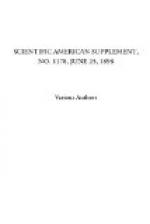But if an inventor takes a given mechanical element for the purpose of its well recognized capacity, and then associates with it another mechanical element for its recognized capacity, but so associates the two elements that one has a modifying effect upon the capacity of the other element, then the association will be capable of a result greater than the sum of the results for the individual elements. This excessive result is not due to the individual elements, but to the combination of them. One has been added to one and a sum greater than two has been secured. The modification of result may be due merely to the bringing of the two elements together, so that they may mutually act upon each other, or it may be due to the manner or means by which they are joined. In a patentable combination the separate elements mutually act upon each other to effect a modification of their previous individual results, and secure a conjoint result greater than the sum of the individual results. The elements of a combination need not act simultaneously; they may act successively, or some may act without motion. As an illustration, assume an old watch in which there was a stem for setting the hands, and assume another old watch with a stem for winding the spring. If an inventor should make a watch, and provide it with the two stems, he would have only an aggregation. But if he employed but one stem, and so located it that it could be used at will for setting the hands or for winding the spring, then he would have produced a combination. The particular instance just given is not a case of the same number of elements, producing a result in excess of the individual results of the separate elements, but is rather a case of a lesser number of elements, producing a combination result equal to the sum of the previous results of a greater number of elements. A better example would perhaps be a new watch with its two old stems so related that either could be used for setting the hands or for winding the spring.
GENERA AND SPECIES.
An inventor, being the first to produce a given organization, and desiring to patent it, may see at once a patentable variation on the device. In other words, he makes two machines patentably different, but both embodying his main invention. He drafts his broad patent claim to cover both machines. In his patent he must illustrate his invention, and he accordingly shows in the drawings the preferred machine. The two machines represent two species of his generic invention, and for illustration he selects the preferable species. He drafts his generic claim to cover both species, and he follows this with a specific claim relating to the selected species. The question might be asked, If the broad generic claim covers the selected and all other species, why bother with the specific claim, why not rest on the generic claim? The answer is that it might in the future develop that




